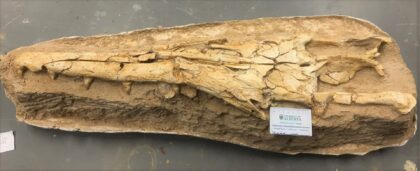 Researchers have recently discovered a new species of ancient marine reptile in Morocco. The sea monster, a long and thin reptile with crocodile-like jaws, preyed on everything it could catch.
Researchers have recently discovered a new species of ancient marine reptile in Morocco. The sea monster, a long and thin reptile with crocodile-like jaws, preyed on everything it could catch.
The new species of the ancient marine reptile that stroke terror into the hearts of the normally safe, fast-swimming fish has been identified by a team of University of Alberta researchers, shedding light on what it took to survive in highly competitive ecosystems.
The first fossil remains of a mosasaur were discovered in a limestone quarry at Maastricht on the Meuse in 1764.
The new type of mosasaur, known as Gavialimimus almaghribensis, was catalogued and named by an international research team led by master’s student Catie Strong, who performed the research a year ago as part of an undergrad honors thesis, guided by vertebrate paleontologist Michael Caldwell, professor in the Faculty of Science, along with collaborators from the University of Cincinnati and Flinders University.
According to the researchers, the monster roamed the sea at the tail end of the Late Cretaceous period between 72 million and 66 million years ago in what is today the Oulad Abdoun Basin in northern Morocco. The mosasaur, known as Gavialimimus almaghribensis, survived in a highly competitive ecosystem. It can reach 17 meters in length and resembles an overgrown komodo dragon.
Analyzing fossils of the animal’s jaw bones, researchers revealed that what differentiates the new Moroccan species from other mosasaurs is that it «has a long, narrow snout and interlocking teeth—similar to the crocodilian gharials, a relative of crocodiles and alligators».
«Its long snout reflects that this mosasaur was likely adapted to a specific form of predation, or niche partitioning, within this larger ecosystem», Catie Strong, who led the research as part of an undergraduate honors thesis explained.
The discovery made in Morocco shows that each species of the sea monster has shown a great deal of adaptation when surviving among other powerful predators. «For some species, these adaptations can be very prominent, such as the extremely long snout and the interlocking teeth in Gavialimimus, which we hypothesized as helping it to catch rapidly moving prey», she said.
Strong’s observations indicate that the reptile fed on everything it could lay its powerful jaws on.
«The narrow, highly elongate snout and interlocking teeth of Gavialimimus almaghribensis are convergent with the condition in gharials, a distinctive taxon of longirostrine crocodilians. In gharials, this morphotype reflects predation on rapidly moving fish, with the interlocking teeth entrapping highly agile prey and the narrow snout reducing drag and displacement of water as the head swings laterally and the jaws snap shut», the study explained.
«This does help give another dimension to that diversity and shows how all of these animals living at the same time in the same place were able to branch off and take their own paths through evolution to be able to coexist like that», Strong said.
The remains of the G. almaghribensis included a meter-long skull and some isolated bones. There was nothing to explain the cause of death of the specimen, which was uncovered in a phosphate mine in Morocco that is rich in fossils.
“Morocco is an incredibly good place to find fossils, especially in these phosphate mines,” Strong said. “Those phosphates themselves reflect sediments that would have been deposited in marine environments, so there are a lot of mosasaurs there.”
Actually, the new study by the Canadian University of Alberta comes following another study by the UK’s University of Portsmouth released in September and which showed that about 100 million years ago, Morocco’s Tafilalet region was home to a river monster, a 15-meter long water dinosaur.
“A discovery of more than a thousand dinosaur teeth, by a team of researchers from the University of Portsmouth, proves beyond reasonable doubt that Spinosaurus, the giant predator made famous by the movie Jurassic Park III as well as the BBC documentary Planet Dinosaur was an enormous river-monster,” said lead study author Thomas Beevor.
The research, published on the journal Cretaceous Research, showed that the region of Tafilalet was once home to massive rivers that could offer a home for such a giant dinosaur.
Until recently, it was believed that dinosaurs lived exclusively on land. However, research published earlier this year showed that Spinosaurus was well adapted to an aquatic lifestyle, due to its newly discovered tail.
And in 2019, a team at the Natural History Museum in London announced the discovery of a new species of stegosaurian dinosaur, Adratiklit boulahfa.
Its remains were uncovered in the Middle Atlas mountains of Morocco, making Adratiklit the first stegosaur to be found in North Africa. According to the researchers, stegosaurian dinosaur is likely to be about 168 million years old.



